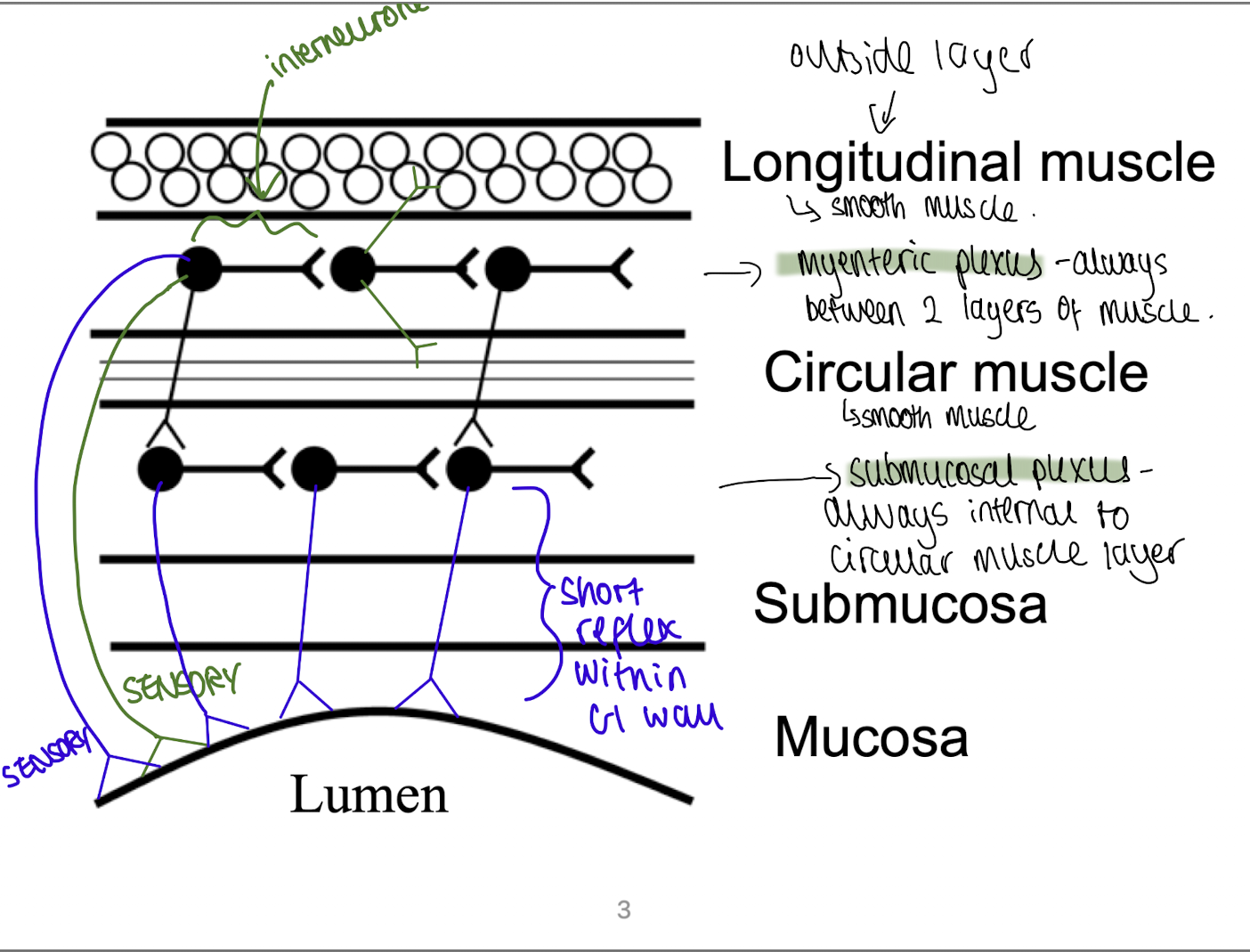The enteric nervous system
0.0(0)
0.0(0)
New
Card Sorting
1/14
There's no tags or description
Looks like no tags are added yet.
Study Analytics
Name | Mastery | Learn | Test | Matching | Spaced |
|---|
No study sessions yet.
15 Terms
1
New cards
features of the enteric NS
* third division of the ANS
* closely related with digestion
* intrinsic innervation of the GI tract
* goes from oesophagus to rectum
* large network of neurones
* closely related with digestion
* intrinsic innervation of the GI tract
* goes from oesophagus to rectum
* large network of neurones
2
New cards
where is the enteric NS?
* submucosal plexus - stomach and intestines only
* myenteric plexus - full length of GIT
* myenteric plexus - full length of GIT
3
New cards
describe the layers of muscle in the gut wall (out to in)
1. longitudinal muscle - outside layer (smooth muscle)
2. myenteric plexus - always between 2 layers of muscle
3. circular muscle - inside layer (smooth muscle)
4. submucosal plexus - always internal to circular muscle
5. submucosa
6. mucosa

4
New cards
what type of neurones are found in the plexus?
* mechanoreceptors and chemoreceptors - afferent sensory
* excitatory and inhibitory interneurones
* excitatory and inhibitory efferent neurones
* motor and secretory effectors - can control GIT very locally via short reflexes
* excitatory and inhibitory interneurones
* excitatory and inhibitory efferent neurones
* motor and secretory effectors - can control GIT very locally via short reflexes
5
New cards
how is food (bolus) pushed from the mouth to the anus?
1. mucosa stimulated by mechanical stretch and presence of chemicals, causing distension
2. excitatory efference is activated for smooth circular muscle contraction behind bolus to push it forward
3. inhibitory efference is activated in front of bolus for relaxation
4. simultaneous contraction and relaxation allows bolus to move onwards and forwards
6
New cards
what is the role of the enteric NS in blood flow?
myenteric and submucosal plexus necessary for control and vasoactive neurotransmitters can influence diameter of blood vessels
7
New cards
describe the motor reflex
1. chemoreceptors detect contents of lumen
2. mechanoreceptors detect how stretched the lumen is
3. a sensory stimulus is detected and the AP is carried up to the myenteric plexus
4. info is processed via interneurones which controls activity of the 2 muscle layers
8
New cards
describe the secretory reflex
1. chemoreceptors detect contents of lumen
2. mechanoreceptors detect how stretched the lumen is
3. sensory stimulus received and AP carried up to myenteric plexus
4. info from sensory afferents taken directly to submucosal plexus
5. interneurones at submucosal plexus process info = activation of afference to stimulate relevant secretion
9
New cards
how does the enteric NS integrate with the CNS?
* interaction with SNS allows ENS to interact with brain = long reflex
* interaction with PNS influences gut function
* interaction with PNS influences gut function
10
New cards
what does heightened sympathetic activity lead to?
increase in brain influence over GI tract function
11
New cards
why does enteric function decline with age?
loss of neurones
12
New cards
chaga’s disease
ingestion of parasite faeces = release of toxins in GI tract = neurone death = loss of gut function
13
New cards
achalasia
affects oesophagus and sphincter - lose ability for efficient peristalsis
14
New cards
hirschsprung disease
born with lack of enteric neurones = less efficient peristalsis = faeces build up in certain areas = distension and inflammation
15
New cards
how can hirschsprung disease be treated?
removal of aganglionic segment